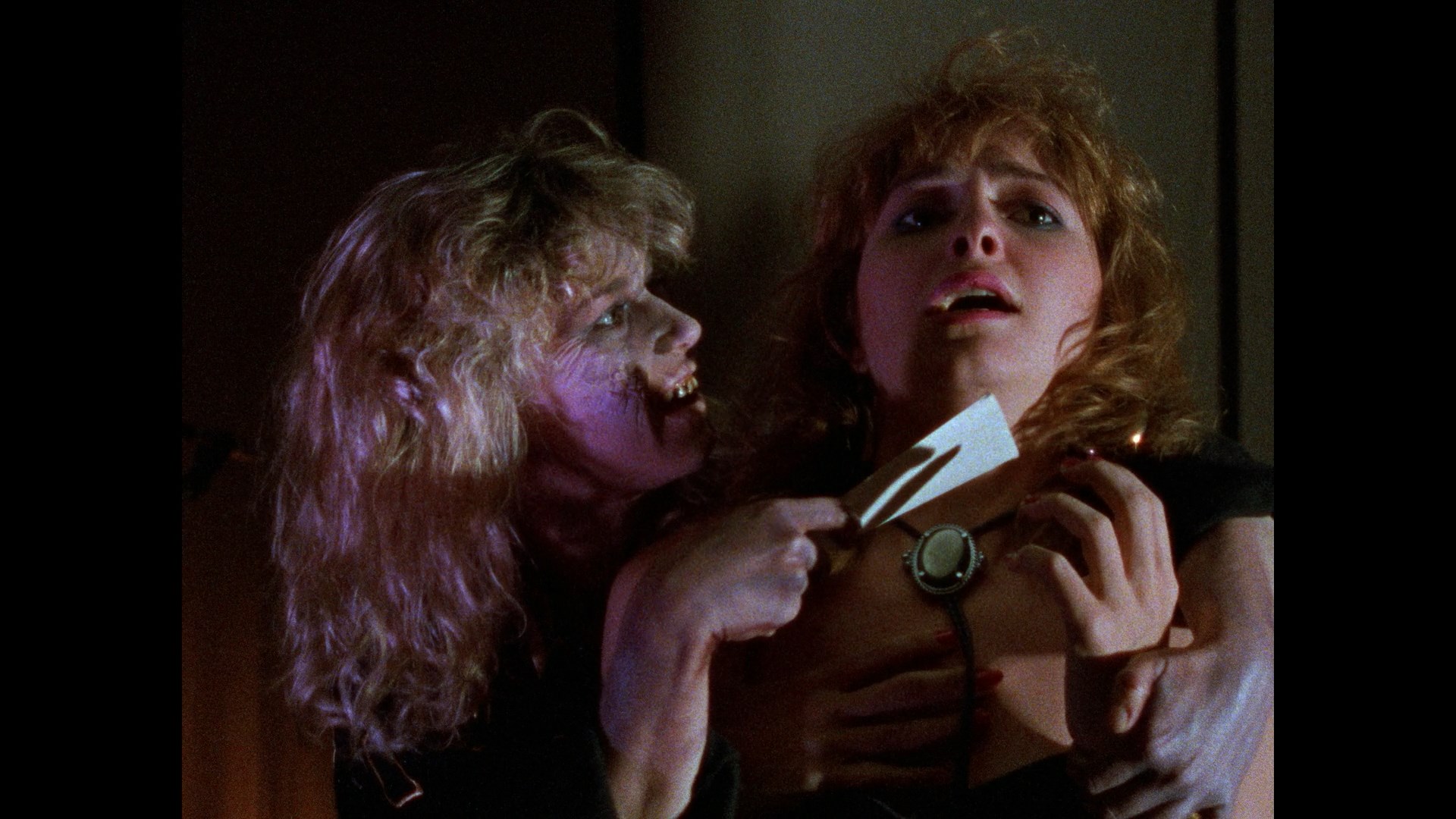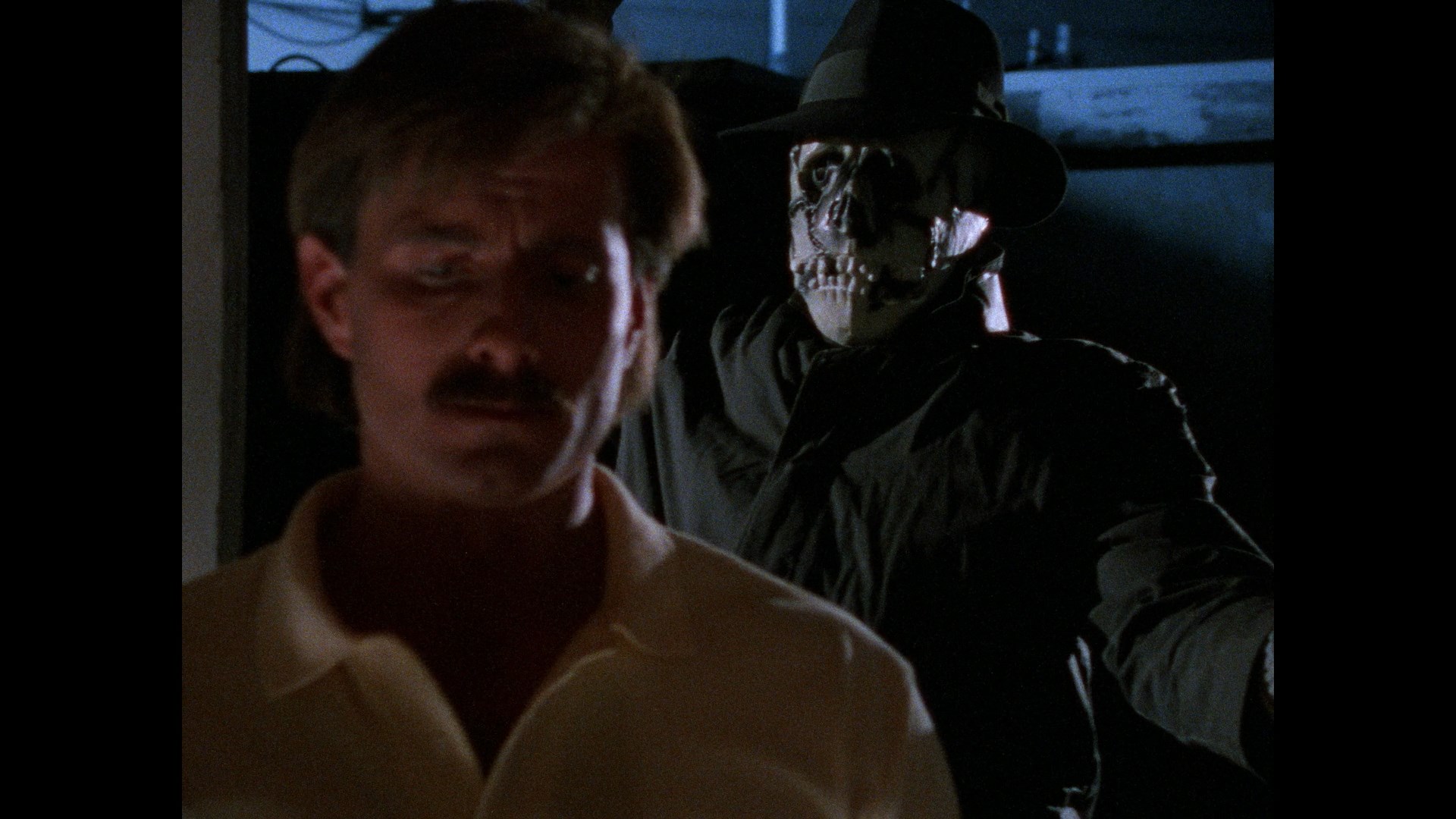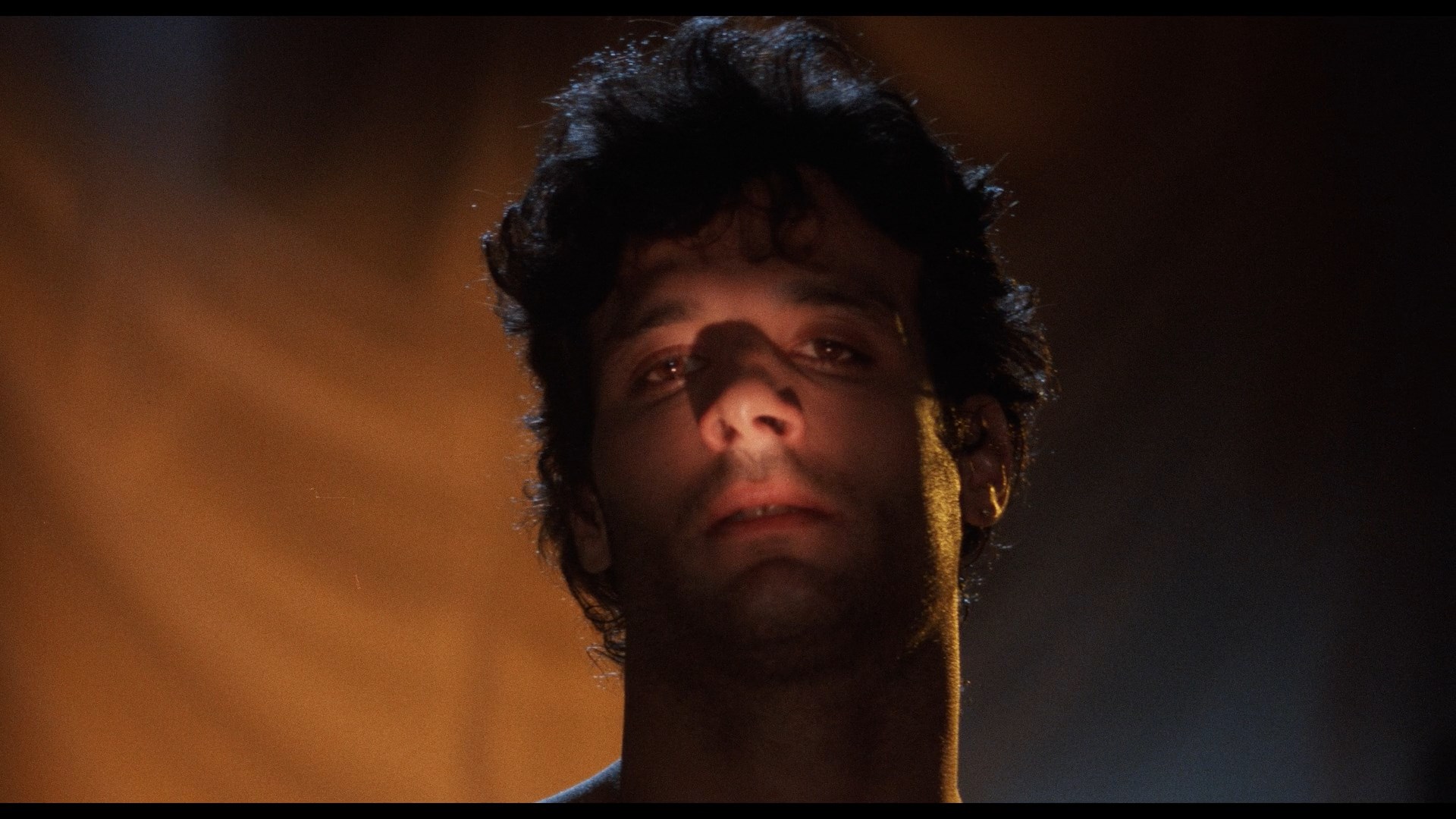

 sets to date, Home Grown Horrors Volume 1was a real godsend for fans of scrappy
sets to date, Home Grown Horrors Volume 1was a real godsend for fans of scrappy  regional horror features shot on film by enterprising filmmakers who often didn't go on to much beyond a title or two on the VHS racks. That philosophy more or less continues in Home Grown Horrors Volume 2, which features another trio of films stacked with features explaining how and why they came to be. Comprised entirely of slasher films (more or less) with some minor supernatural elements at times, this one shakes things up a little since one title is actually a fairly slick Los Angeles production. However, they all have their own offbeat charms that make this box a worthy successor.
regional horror features shot on film by enterprising filmmakers who often didn't go on to much beyond a title or two on the VHS racks. That philosophy more or less continues in Home Grown Horrors Volume 2, which features another trio of films stacked with features explaining how and why they came to be. Comprised entirely of slasher films (more or less) with some minor supernatural elements at times, this one shakes things up a little since one title is actually a fairly slick Los Angeles production. However, they all have their own offbeat charms that make this box a worthy successor.  word of mouth following as much for its scarcity as for its crazy-quilt approach to the slasher template including a unforgettable seesaw finale that
word of mouth following as much for its scarcity as for its crazy-quilt approach to the slasher template including a unforgettable seesaw finale that  really has to be seen to be believed. It's turned up over the years in a couple of legally dubious editions (including a brief BD-R), but the Vinegar Syndrome Blu-ray is definitely the way to go complete with a ridiculously crisp and impressive a/v presentation from a 4K restoration of the 16mm original camera negative. Anyone who suffered through the old VHS version will be gobsmacked at how fresh it looks here, with the DTS-HD MA English 2.0 mono track (with optional English SDH subtitles, like the other two films here) now crystal clear as well. Cinematographer Michael Goi (who went on to a successful Hollywood career -- as well as Hellmaster), producer Sally O'Rourke, production manager John Strysik, and actresses Kelly Mullis and Joleen Mullins appear for a new commentary track and also turn up in a feature-length documentary, "Camper Stamper Lives: Resurrecting Moonstalker" (95m47s), in which they talk about the initial aborted financing through an Irish brewery, the freezing shooting conditions, and the personnel from Tales from the Darkside, Surf II, and the obscure VHS horror Deadly Love. Unfortunately many of the participants are unidentified on screen, but there's a lot of solid material here with some of the best provided by Goi and Strysik. There's also a nice appearance near the end from composer Douglas Pipes, who went on to the far more widely seen Trick 'r Treat, Krampus, and Monster House. A second audio commentary features the slasher-crazy gang from The Hysteria Continues, who are more than up to the task here talking about the film's video history, its place in the weird twilight period of the original slasher era, the shooting conditions, and the genre connections from many of the talent in front of and behind the camera. Also included are a 2m1s still gallery and the very lo-fi archival "Camper Stamper Caper" (70m5s) documentary showcasing the late director Michael O'Rourke and loaded with VHS coverage of the making of the film itself.
really has to be seen to be believed. It's turned up over the years in a couple of legally dubious editions (including a brief BD-R), but the Vinegar Syndrome Blu-ray is definitely the way to go complete with a ridiculously crisp and impressive a/v presentation from a 4K restoration of the 16mm original camera negative. Anyone who suffered through the old VHS version will be gobsmacked at how fresh it looks here, with the DTS-HD MA English 2.0 mono track (with optional English SDH subtitles, like the other two films here) now crystal clear as well. Cinematographer Michael Goi (who went on to a successful Hollywood career -- as well as Hellmaster), producer Sally O'Rourke, production manager John Strysik, and actresses Kelly Mullis and Joleen Mullins appear for a new commentary track and also turn up in a feature-length documentary, "Camper Stamper Lives: Resurrecting Moonstalker" (95m47s), in which they talk about the initial aborted financing through an Irish brewery, the freezing shooting conditions, and the personnel from Tales from the Darkside, Surf II, and the obscure VHS horror Deadly Love. Unfortunately many of the participants are unidentified on screen, but there's a lot of solid material here with some of the best provided by Goi and Strysik. There's also a nice appearance near the end from composer Douglas Pipes, who went on to the far more widely seen Trick 'r Treat, Krampus, and Monster House. A second audio commentary features the slasher-crazy gang from The Hysteria Continues, who are more than up to the task here talking about the film's video history, its place in the weird twilight period of the original slasher era, the shooting conditions, and the genre connections from many of the talent in front of and behind the camera. Also included are a 2m1s still gallery and the very lo-fi archival "Camper Stamper Caper" (70m5s) documentary showcasing the late director Michael O'Rourke and loaded with VHS coverage of the making of the film itself. Film number two, Dead Girls, is a very, very early '90s effort sporting an spectacular concept that the
Film number two, Dead Girls, is a very, very early '90s effort sporting an spectacular concept that the  filmmakers inexplicably refuse to carry through at every step. Just imagine: it's a slasher film about an a mostly female rock band with members like Bertha Beirut and Nancy Napalm who end up getting stalked by a killer inspired by their lyrics. For some reason we're deprived of any actual song performances, and the film shuffles around aimlessly for half an hour before finally getting down to business during its protracted 105-minute running time. Luckily there is a payoff for gore fans though once the killings start including a justly celebrate axe slaying, while the decision to pack most of the suspense scenes in broad daylight is an interesting one. The band Dead Girls is on the rise with its lead singer, Lucy Lethal, more or less speaking for them. Other members include Bertha Beirut a.k.a. Gina Varelli (Karanikias), Lucy's drummer brother Randy Rot (Kyle), and Nancy Napalm who uses ammo and a gun guitar. Their songs focusing on death and pain are being old hat for manager Artie (Chin), who wants them to break out to a more mainstream audience. However, their next gigs are thrown into disarray when Gina, who's prone to prophetic nightmares, gets a letter about her sister Brooke's attempted wrist-slashing suicide that's left her in a coma. A trip back home to some very unpleasant parents sends Gina and company on a two-week sabbatical to a remote cabin where a killer wearing a skull mask and a fedora starts to hunt them all down.
filmmakers inexplicably refuse to carry through at every step. Just imagine: it's a slasher film about an a mostly female rock band with members like Bertha Beirut and Nancy Napalm who end up getting stalked by a killer inspired by their lyrics. For some reason we're deprived of any actual song performances, and the film shuffles around aimlessly for half an hour before finally getting down to business during its protracted 105-minute running time. Luckily there is a payoff for gore fans though once the killings start including a justly celebrate axe slaying, while the decision to pack most of the suspense scenes in broad daylight is an interesting one. The band Dead Girls is on the rise with its lead singer, Lucy Lethal, more or less speaking for them. Other members include Bertha Beirut a.k.a. Gina Varelli (Karanikias), Lucy's drummer brother Randy Rot (Kyle), and Nancy Napalm who uses ammo and a gun guitar. Their songs focusing on death and pain are being old hat for manager Artie (Chin), who wants them to break out to a more mainstream audience. However, their next gigs are thrown into disarray when Gina, who's prone to prophetic nightmares, gets a letter about her sister Brooke's attempted wrist-slashing suicide that's left her in a coma. A trip back home to some very unpleasant parents sends Gina and company on a two-week sabbatical to a remote cabin where a killer wearing a skull mask and a fedora starts to hunt them all down.  especially with potential red herrings around like a suspicious doctor and a gang of Brooke's obsessed teen pals with a
especially with potential red herrings around like a suspicious doctor and a gang of Brooke's obsessed teen pals with a  suicide pact. This marked the second horror feature (and the first one shot on film, 16mm in this case) for director Dennis Devine and writing and producing partner Steve Jarvis, who debuted with Fatal Images and went on to tons of later low-budget titles like the Things anthology films, Alice in Murderland, and some of the Axegrinder and Camp Blood films. Both of them are present for an audio commentary on the Vinegar Syndrome disc and take part in a lengthy new making-of documentary, "Dead Girls Rock: Looking Back at Dead Girls" (92m44s), joined by actors Angela Scaglione, Jeff Herbick, Brian Chin, Ilene Singer, Robert Harden, and Kay Wolf, plus composer Erik Ekstrand, which covers pretty much every imaginable detail about the production and their respective backgrounds that you could possibly want to know. Not surprisingly, Devine and Jarvis cite their viewings of gialli as a big influence with Blood and Black Lace clearly inspiring the look of the killer here. Even less surprising is the revelation that Devine usually just went along with a single take of each scene, which explains the nature of most of the performances. A second commentary track features The Hysteria Continues again, and as usual they're great guides to this one as they parse out some of the more inexplicable creative decisions while noting the highlights of rock-themed slasher films and the rapidly declining state of the subgenre by the early '90s. A pretty gory 58s still gallery is also included. As for the film itself, it looks great with a 1.33:1 presentation from a 4K scan of the 16mm original camera negative; no complaints in that area at all, while the DTS-HD MA 2.0 English mono track (with English SDH subtitles) does what it can given that aforementioned terrible sound mix.
suicide pact. This marked the second horror feature (and the first one shot on film, 16mm in this case) for director Dennis Devine and writing and producing partner Steve Jarvis, who debuted with Fatal Images and went on to tons of later low-budget titles like the Things anthology films, Alice in Murderland, and some of the Axegrinder and Camp Blood films. Both of them are present for an audio commentary on the Vinegar Syndrome disc and take part in a lengthy new making-of documentary, "Dead Girls Rock: Looking Back at Dead Girls" (92m44s), joined by actors Angela Scaglione, Jeff Herbick, Brian Chin, Ilene Singer, Robert Harden, and Kay Wolf, plus composer Erik Ekstrand, which covers pretty much every imaginable detail about the production and their respective backgrounds that you could possibly want to know. Not surprisingly, Devine and Jarvis cite their viewings of gialli as a big influence with Blood and Black Lace clearly inspiring the look of the killer here. Even less surprising is the revelation that Devine usually just went along with a single take of each scene, which explains the nature of most of the performances. A second commentary track features The Hysteria Continues again, and as usual they're great guides to this one as they parse out some of the more inexplicable creative decisions while noting the highlights of rock-themed slasher films and the rapidly declining state of the subgenre by the early '90s. A pretty gory 58s still gallery is also included. As for the film itself, it looks great with a 1.33:1 presentation from a 4K scan of the 16mm original camera negative; no complaints in that area at all, while the DTS-HD MA 2.0 English mono track (with English SDH subtitles) does what it can given that aforementioned terrible sound mix. Finally we go completely off the deep end on disc three with Hanging Heart, an
Finally we go completely off the deep end on disc three with Hanging Heart, an  incredibly obscure but glossy erotic thriller that also tips its hat to gialli and slashers -- albeit here with so much homeroticism it zooms past subtext and primary text to a level so crazed it defies description. This one was initially picked up for U.S. distribution by Nico Mastorakis' Omega Entertainment, but instead the film only ended up getting a very marginal VHS release in a handful of European territories like Poland and Hungary. Though it runs almost as long as Dead Girls, Hanging Heart packs its running time with a lot more "WTF?" moments and is bound to build up some sort of cult reputation, even if it's also going to unavoidably be the most divisive title in this set.
incredibly obscure but glossy erotic thriller that also tips its hat to gialli and slashers -- albeit here with so much homeroticism it zooms past subtext and primary text to a level so crazed it defies description. This one was initially picked up for U.S. distribution by Nico Mastorakis' Omega Entertainment, but instead the film only ended up getting a very marginal VHS release in a handful of European territories like Poland and Hungary. Though it runs almost as long as Dead Girls, Hanging Heart packs its running time with a lot more "WTF?" moments and is bound to build up some sort of cult reputation, even if it's also going to unavoidably be the most divisive title in this set. if things don't make a ton of sense, and it's interesting to see Wyatt in his debut here before
if things don't make a ton of sense, and it's interesting to see Wyatt in his debut here before  he started turning up in plenty of films over the next decade.
he started turning up in plenty of films over the next decade. ![]()